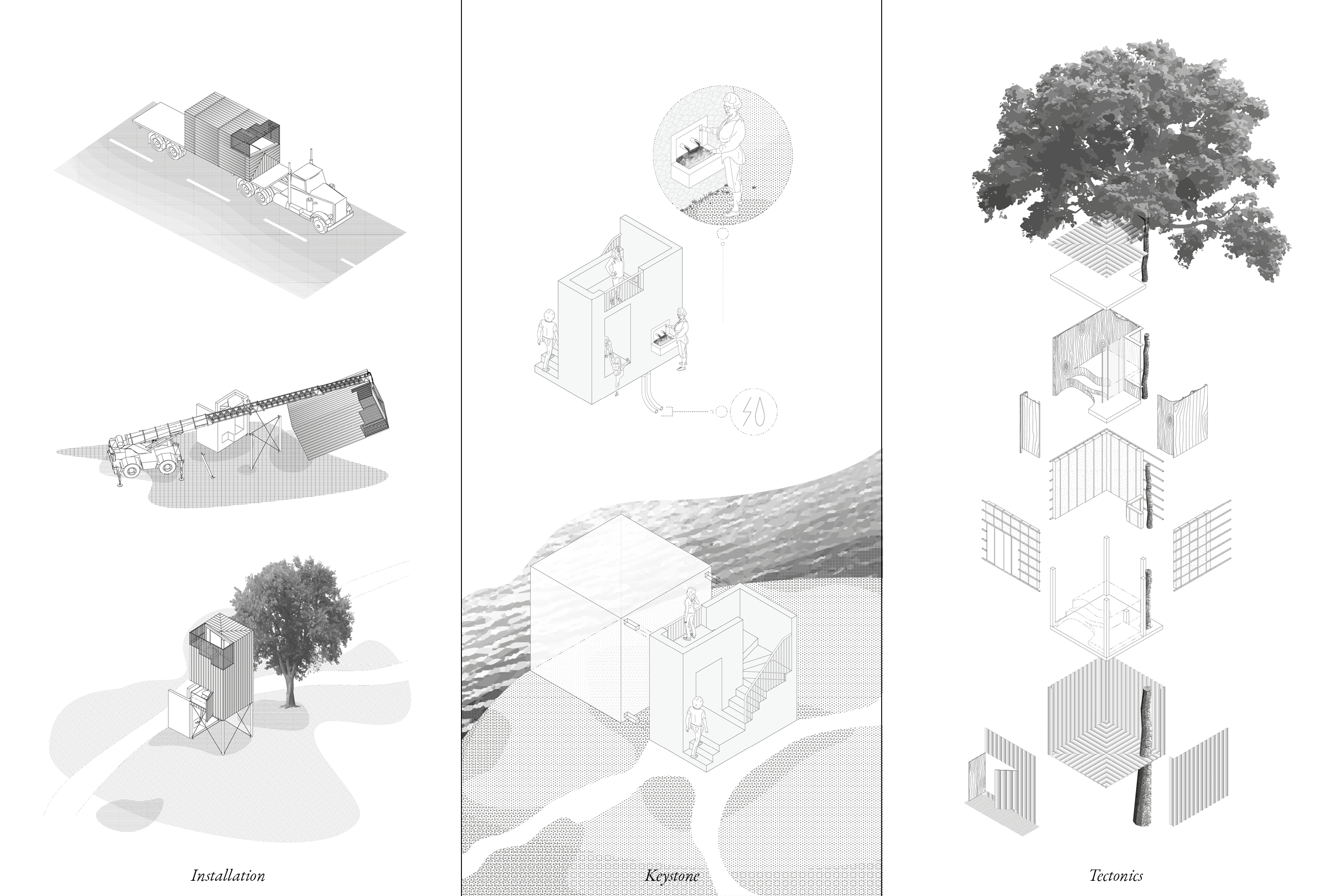




Folie à deux is the name given to a combined hallucination, where two people share the same fantasy or dream. To us, this combined ‘folie’ is much like the architectural folly; a Romantic era architectural typology of decorative buildings that were constructed in the landscape as scenery. The structures were imagined and designed as part of a fictional narrative. In the age of medieval nostalgia this meant follies often took the form of ruined castles or turrets.
‘Folie à trois’ proposes a new typology of folly for the Dartagnans castle sites to be inhabited by visitors and experienced as you move through the landscape. The typology consists of two parts, the folly and the keystone. The keystone is constructed from locally quarried stone in reference to the grand castle that the land used to serve - it is a functional as well as scenic element. Visitors can use it as a viewing platform, an oasis to refresh with water, a place to play or to rest.
The second element, the folly, uses this keystone as a node to connect to the key services required, and to provide access and structural support. The various follies - ‘the tree folly’, ‘the forest folly’ and ‘the lake folly’ - are prefabricated, yet small enough to be shipped to site and installed using only simple tools and hand-driven metal piles. The design of the keystone allows for multiple threshold conditions in accordance with each of the types so that these modules are also interchangeable between the different locations on the site.
The follies have a fluted aluminium exterior cladding that obliquely imitates the neoclassical elements of the ruined castles whilst reflecting the surrounding landscape in the panels. Yet, behind the pure, unitary form of the facade the micro-living interior is organic and warm, designed to echo the imagined feeling of a hollow tree trunk. Light is brought in through windows that seem carved from the walls, which are hidden by shutters than can be adjusted for privacy or illumination.
The enfolding timber skin of the internal finishes is both removable and recyclable - allowing new configurations to inhabit the same shell. At the end of its life cycle the folly can be decoupled from its keystone and fully disassembled. In reuse, the timber construction acts as a carbon store whilst aluminium produces the least waste during its recycling process compared to other metals. Like the fantasy it helps to realise, the folly is fleeting, disappearing once the story is gone.
︎︎︎ ︎︎︎
‘Folie à trois’ proposes a new typology of folly for the Dartagnans castle sites to be inhabited by visitors and experienced as you move through the landscape. The typology consists of two parts, the folly and the keystone. The keystone is constructed from locally quarried stone in reference to the grand castle that the land used to serve - it is a functional as well as scenic element. Visitors can use it as a viewing platform, an oasis to refresh with water, a place to play or to rest.
The second element, the folly, uses this keystone as a node to connect to the key services required, and to provide access and structural support. The various follies - ‘the tree folly’, ‘the forest folly’ and ‘the lake folly’ - are prefabricated, yet small enough to be shipped to site and installed using only simple tools and hand-driven metal piles. The design of the keystone allows for multiple threshold conditions in accordance with each of the types so that these modules are also interchangeable between the different locations on the site.
The follies have a fluted aluminium exterior cladding that obliquely imitates the neoclassical elements of the ruined castles whilst reflecting the surrounding landscape in the panels. Yet, behind the pure, unitary form of the facade the micro-living interior is organic and warm, designed to echo the imagined feeling of a hollow tree trunk. Light is brought in through windows that seem carved from the walls, which are hidden by shutters than can be adjusted for privacy or illumination.
The enfolding timber skin of the internal finishes is both removable and recyclable - allowing new configurations to inhabit the same shell. At the end of its life cycle the folly can be decoupled from its keystone and fully disassembled. In reuse, the timber construction acts as a carbon store whilst aluminium produces the least waste during its recycling process compared to other metals. Like the fantasy it helps to realise, the folly is fleeting, disappearing once the story is gone.
︎︎︎ ︎︎︎
